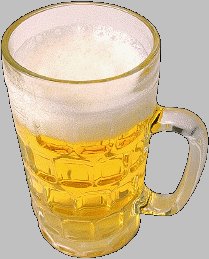 The brewing process consists of nine key components: Malting, milling, mashing, brewing, cooling, fermentation, racking and finishing.
The brewing process consists of nine key components: Malting, milling, mashing, brewing, cooling, fermentation, racking and finishing.Malting is the process of getting the barley ready for brewing. Each step of the malting process unlocks the starches hidden in the barley.
Step 1. Steeping
The grain is added to a vat along with water and allowed to soak for about 40 hours.
Step 2. Germination
The grain is then spread out on the floor of the germination room for about five days where rootlets begin to form. The goal of germination is for the starches within the grain to breakdown into shorter lengths. At the end of this step, the grain is called green malt.
Step 3. Kilning
The green malt now goes through a high temperature drying in a kiln. It is important that temperature increases are gradual so that the enzymes in the grain are not damaged.
After kilning, the result is a finished malt. There are different types of malts: pale malts are dried at a low temperature; mild ale malts are kilned to a slightly higher temperature and produce a deeper color in the final beer. The highest temperatures are used to produce very flavorful and aromatic malts.
Milling is the cracking of the grain which the brewer chooses for the particular batch of beer. Milling the grain allows it to absorb the water it will eventually be mixed with (in order for the water to extract sugars from the malt).
Mashing converts the starches, which were released during the malting stage, to sugars that can be fermented. The milled grain is dropped into warm water in a large cooking vessel called the mash tun. In this mash tun, the grain and water mix to create a cereal mash. Because water is such a vital part of the brewing process, the water itself is a key ingredient. This sugar rich water is then strained through the bottom of the mash and is now called wort.
Brewing. The wort now goes to the brew kettle where it is brought to a boil. The boiling stage of brewing involves many technical and chemical reactions. During this stage, important decisions will be made affecting the flavor, color and aroma of the beer. Certain types of hops are added at different times during the boil for either bitterness or aroma.
Cooling. The wort is transferred quickly from the brew kettle through a device to filter out the hops, and then onto a heat exchanger to be cooled. The heat exchanger basically consists of tubing inside of a tub of cold water. It is important to quickly cool the wort to a point where yeast can safely be added, because yeast does not grow in high heat.
Fermentation. After passing through the heat exchanger, the cooled wort goes to the fermentation tank. The brewer now selects a type of yeast and adds it to the fermentation tank. This is where the "real magic" of brewing happens- where the yeast ferments the wort sugars into alcohol.
Racking. During this phase, the brewer moves, or racks, the beer into a new tank called the conditioning tank. The brewer then waits for the beer to complete its aging process.
Finishing. The last step in the brewing process is filtration, and then carbonation. Next the beer is moved to a holding tank where it stays until it is bottled or kegged.
3 comments:
Great work!
[url=http://knemywbg.com/mujg/gcai.html]My homepage[/url] | [url=http://ruvzsgkh.com/kfcq/ltos.html]Cool site[/url]
Great work!
My homepage | Please visit
Thank you!
http://knemywbg.com/mujg/gcai.html | http://vldcneki.com/umyh/ssjn.html
Post a Comment